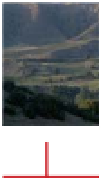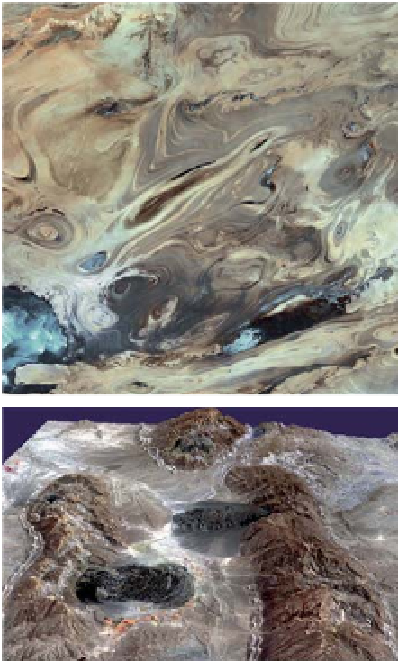Geology Reference
In-Depth Information
important in the marine Permian and
Triassic sequences in Europe. They
form convenient glide planes for thrust
sheets in the Alps, and in northern
Germany a Permian salt layer has
developed into numerous salt domes
and diapirs. The way these structures
develop is illustrated diagrammatically
in Figure 9.4. The low-density salt layer
is overlain by higher-density sedimen-
tary layers that exert a downward gravi-
tational pressure on the salt. A slight
local thickening of the salt layer can
focus the salt into a dome-like or anti-
clinal structure, since the salt can be
squeezed sideways by the gravitational
load on either side. Nearly a kilometre
of sediments is required to produce a
sufficiently large gravitational pressure
to start the process, but having started,
the salt will tend to proceed upwards
due to its buoyancy, aided perhaps
by extensional fracturing of overlying
layers. Once the salt has breached the
overlying layer, it forms a
salt diapir
(Figure 9.4.3). When it reaches a level
where it is more gravitationally stable,
it will spread sideways to form a mush-
room-like structure, as shown in Figure
9.4.4, which may eventually become
completely detached from its roots.
Salt bodies form a variety of shapes
(Figure 9.5A): if the initial disturbance
is roughly equi-dimensional, they
will evolve into a
salt dome
and then
a
salt plug
, which is approximately
9
76
77
sl
Figure 9.4
Evolution of a
salt diapir. The salt layer is
gravitationally unstable since it
is less dense and has a lower
viscosity than the overlying rock.
Stage (1): a slight thickening of
the salt layer is present at the
site of the future diapir; (2) the
gravitational load of the overlying
layers a and b squeeze the salt
sideways into a dome shape;
extensional faults develop in
the overlying competent layer
a while deposition of layer c
onlaps the sides of the dome;
(3) with further doming, the
salt breaks through the faulted
layer a and spreads sideways
into layer b to become a diapir;
layers a, b and c are domed
upwards and distorted into
two asymmetrical synclinal
structures at the sides of the
diapir, while deposition of layer d
takes place around its sides; (4)
the diapir is now fully developed
by spreading sideways into layer
c, where it will now be more
stable gravitationally. Based on
Trusheim (1960).
A
d
c
4
b
a
sl
d
c
salt
diapir
3
b
a
a
B
sl
c
b
2
a
salt
dome
Figure 9.5
Salt domes in Iran.
A.
Satellite image of salt domes and
related structures in the Dasht-e Kavir (Great Salt Desert), Central
Iran; the salt domes are roughly circular in plan and possess a
series of concentric rings; note the swirling pattern of the folded
sedimentary layers between the domes.
B.
Salt glaciers flowing
from salt domes in the Zagros Mountains; the glaciers are over
5 km long; the dark colour is due to clay covering the salt surface.
Both images courtesy of NASA.
sl
b
a
1
b
a
salt layer



























Search WWH ::

Custom Search